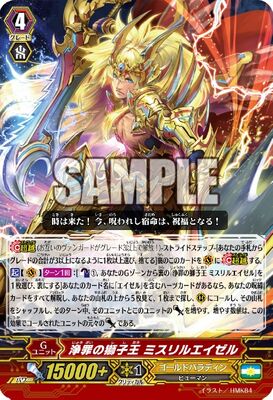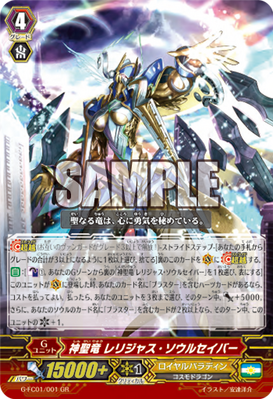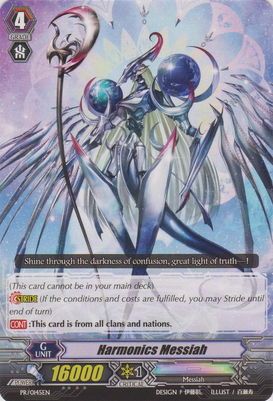 That being said, when Bushiroad first introduced Stride, they advertised it as something that could revitalize old cards, bringing previously forgotten boss units back on par with the rest of the game. But how true was this statement? While its true that Stride can be used with any Grade 3 lineup, like old ones from Season 1, it can also be used with newer units. If you think of Stride as being a +2 to how good a deck is, its just a flat increase that helps good and bad decks alike: The power gap between old and new cards would, theoretically, stay the same. So how much merit is there to Bushiroad's statement?
That being said, when Bushiroad first introduced Stride, they advertised it as something that could revitalize old cards, bringing previously forgotten boss units back on par with the rest of the game. But how true was this statement? While its true that Stride can be used with any Grade 3 lineup, like old ones from Season 1, it can also be used with newer units. If you think of Stride as being a +2 to how good a deck is, its just a flat increase that helps good and bad decks alike: The power gap between old and new cards would, theoretically, stay the same. So how much merit is there to Bushiroad's statement?
First off, I'm going to define what determines an "old" boss unit. Its generally accepted that Set 10 was the beginning of a huge power creep for the game: 11,000 became the standard base power, we started moving away from the conversion of 2 Counterblasts = 1 card in terms of advantage (and closer to the 1 CB = 1 card conversion that we have now), and the game just got a lot faster overall. "Final turn" plays (thanks to Limit Break bosses and Break Rides) became the norm, rather than a flat-out battle of attrition. Even when these Season 3 bosses became obsolete due to Legion, Season 4 introduced the Limit Break enabling Grade 1's, which made Set 10+ units viable again (at least more so than before). So, for the purposes of this article, any card printed in Set 9 or before is a valid "old" boss unit. Additionally, cards like Vermillion and Blaukluger, which have received updated support for Post-Set 10 standards won't be addressed or included in this article.
Incandescent Lion, Blonde Ezel and the "Ezel" Sub-clan
In Fighter's Collection 2015, Purgation Lion Emperor, Mithril Ezel was revealed. Requiring an "Ezel" Heart, this card was meant to be direct support for the should-be-forgotten sub-clan of "Ezel" cards. Its skill brilliantly combined the skills of all 3 other Ezel incarnations in the form of field generation, Vanguard/Rear Guard buffs, and mass unlocking. The card itself, while a jack of all trades, is a master of none. It suffers from trying to do too many things and, due to balance, not being able to do them all exceptionally well. It increases Vanguard power, but being a Stride unit, power gain is only good for so much until it just becomes excessive. It gives the player access to a field unlock when playing against Link Joker, but Ezel Scissors already was capable of doing that, and since this card requires an "Ezel" Heart, it isn't exactly splashable and usable in any other Gold Paladin deck. It will double the power of a Rear Guard it calls, and lets you pick from the top 5 cards of your deck as opposed to just taking the top card like its initial form did, which is a nice bonus late-game, but ultimately this can be done better by units like Conquest Dragon, who can give your entire front row a 10,000 Power buff AND generates just as much advantage.
Additionally, Mithril doesn't so much help the other "Ezel" units as it does replace them. Its a cheaper and more usable version of Incandescent Lion's Limit Break ability, as well as a more accessible and cheaper version of Scissors' unlock skill. Its arguable that it could combo fairly well with Platina Ezel's Ultimate Break ability, since 2 turns of Mithril and a pumped up Rear Guard's attacks would/should whittle the opponent down enough that a 5,000 boost to your entire field with Platina would be quite the onslaught. However, Platina being an Ultimate Break means its not too hard for the opponent to deny you access to his skill, since 4 damage still puts you within kill range. Mithril doesn't really set up Incandescent or Scissors for later turns, and realistically Scissors is the only unit that's really worth its salt if you find yourself in a position where you can't Stride. However, since all 3 Grade 3 forms of Ezel are pretty much outclassed by current boss units, I don't see Mithril giving the deck any meaningful power upgrade. It will make it so the deck is at least usable in the current format, and it would definitely give people a run for their money in a local setting, but the stark lack of "Ezel" support, and a lack of a coherent theme for the sub-clan as a whole, is just something you can't fix with just 1 Stride unit. Did Mithril make the Ezel deck better? Yes. Did it make them good and viable? No.
Majesty Lord Blaster and "Blaster" Units
With the reveal of Holy Dragon, Religious Soul Saver, any Grade 3 "Blaster" unit got a pretty major upgrade. Soul Saver as a Grade 3 unit was strong back in the day, but suffered from being slow, inconsistently, costly, and eventually just too conditional for the way the game was headed. A much cheaper and on-demand Soul Saver? That's scary. That's Religious Soul Saver.
If you have a "Blaster" Heart, Religious Soul Saver gives 5,000 Power to 3 of your units. This is the same buff the original Soul Saver gave, but much cheaper, and this unit has a base 25-26,000 Power as opposed to 10,000. Since "Blaster Blade (Seeker)" is the mate to just about every Seeker boss ever printed, this card gave a nice boost to Legion decks, especially Thing Saver Dragon. The real clincher, though is that Religious Soul Saver gains an extra critical if you have 2 or more "Blaster" units in your soul. This is an extra little bonus that is almost exclusive to Majesty Lord Blaster, who is currently the only unit that can fulfill this condition consistently and easily.
But is it enough to make MLB relevant again? MLB is a skill that is live the turn you ride him, even if your opponent is still on Grade 2, which is a convenience no other modern deck mechanic shares, as Legion and Stride both require all players to have Grade 3 Vanguards. This means, if you happen to go first, you can use MLB's skill and get 2 Blasters into the soul before you have your first chance at Striding, so you don't even have to miss a beat before Striding into Religious Soul Saver. His innate critical means you can realistically push the opponent from 2 to 4 or even 5 damage in 1 attack. If they get scared of this and block him, then Striding into RSS the following turn means they have to deal with the same situation again, but this time with Triple Drive, higher base power, and stronger Rear Guards.
But will this make MLB a relevant deck again? That certainly remains to be seen. His extremely powerful early game and very weak late game complements Stride's powerful late game very nicely, and with more and more Royal Paladin support, he can only get better. The Stride-era support is based around calling Grade 2 units, and guess what the two key combo pieces in the MLB Deck happen to be? The removal of clan restrictions on skills also means most of this support can also target Blaster Dark, which is a huge plus. Religious Soul Saver does the job of a Stride unit perfectly: It complements the Grade 3 it was supposed to help, rather than attempt to replace it.
Oracle Think Tank's Fan Favorites: CoCo and Tsukuyomi
Oracle Think Tank, back in the day, was one big advantage engine, infamous for its massive hands and tank power. Lack of support for half of the game, on top of a failed attempt at a change in identity/mechanic, left them in the dust for a very long time. With G-Booster 1, however, they received revitalizing support in the form of Supreme Heavenly Battle Deity, Susanoo and their 2 initial Stride units. Lack of an additional boss unit, however, forced OTT players to dig back into their Set 1 and 2 card pool to find partners for their godsend of an on-stride unit, and their support is the prime example of what Stride was supposed to do.
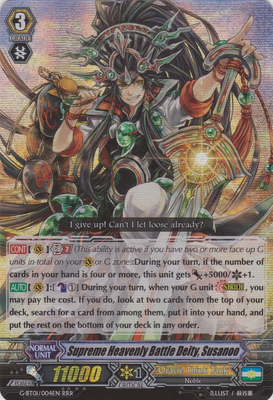 The first boss unit is Scarlet Witch, CoCo, who was infamous in the Set 7 era for being a massive tank of a deck. Being one of the first cards to actually net you a +2 for 2 Counterblasts, her stipulation of requiring 1 or fewer soul (in a deck that was partially known for hoarding soul) was a huge wall until Set 7 debuted with Little Witch, LuLu, who was basically a CoCo-enabler. The deck flourished for being able to draw 3 cards the turn you rode Grade 3, which was an incredible amount of advantage for its time (and is still even cost-efficient in the current meta). It fell out of the meta due to the fact that, beyond this initial burst of advantage, it really relied on the opponent not being able to whittle your hand down or you sacking a few crits and putting them on Silent Tom. Once the Set 10 power creep hit, CoCo was all but obsolete with her lack of finishing power and ways to keep the advantage coming. The G-Booster 1 support, however, was just what she needed. After riding her and gaining your absurd 3 cards, you could immediately start Striding and keep the pressure on the opponent. High-powered Vanguards coupled with Stride units that were capable of keeping the advantage flowing even after riding CoCo made the deck a force to be reckoned with. Tournament reports speak for themselves if you want to know if this deck actually revitalized CoCo or not.
The first boss unit is Scarlet Witch, CoCo, who was infamous in the Set 7 era for being a massive tank of a deck. Being one of the first cards to actually net you a +2 for 2 Counterblasts, her stipulation of requiring 1 or fewer soul (in a deck that was partially known for hoarding soul) was a huge wall until Set 7 debuted with Little Witch, LuLu, who was basically a CoCo-enabler. The deck flourished for being able to draw 3 cards the turn you rode Grade 3, which was an incredible amount of advantage for its time (and is still even cost-efficient in the current meta). It fell out of the meta due to the fact that, beyond this initial burst of advantage, it really relied on the opponent not being able to whittle your hand down or you sacking a few crits and putting them on Silent Tom. Once the Set 10 power creep hit, CoCo was all but obsolete with her lack of finishing power and ways to keep the advantage coming. The G-Booster 1 support, however, was just what she needed. After riding her and gaining your absurd 3 cards, you could immediately start Striding and keep the pressure on the opponent. High-powered Vanguards coupled with Stride units that were capable of keeping the advantage flowing even after riding CoCo made the deck a force to be reckoned with. Tournament reports speak for themselves if you want to know if this deck actually revitalized CoCo or not.
But the soulless ginger wasn't the only one making new friends. The original meta OTT deck, Goddess of the Full Moon Tsukuyomi, benefits just as much from the new support as CoCo does. The Tsukuyomi Ride Chain is a model of consistency: Not only can you ride normally as any deck would do, each piece of the ride chain searches the top 5 cards of the deck and gives you a chance of riding the next Grade from there. Not only does this give you a +1 in terms of raw advantage if its successful, it also creates a stack at the bottom of the deck which you control the order of. The general strategy of the Tsukuyomi deck is to plow through your deck as fast as possible to reach this stack, remember where you stacked your double crits, and then "sack" the opponent to death. Not only do the new OTT units provide updated ways of advantage generation, they also add to her stack. Susanoo and Kirin both cycle 2 cards from the top of the deck onto the bottom, and Takemikazuchi moves 4. She has also been confirmed for getting a Stride update in the Fighter's Collection 2015, which will no doubt just add to her arsenal of tricks. One of the most consistent riding mechanics in the game, coupled with updated advantage engines and even faster ways to dig to your stack has made Tsukuyomi just as powerful and threatening as CoCo, possibly even more so.
Nifty Combo's or a Fool's Dream?
While the above cards received support designed directly with them in mind, there are also a few combo's available now that are a result of mechanics interacting with each other in unforeseen ways. One of the best examples of this comes in the form of White Hare in the Moon's Shadow, Pellinore. When Set 7 came out, Pellinore was all the rage of Gold Paladin users. He was a re-riding Vanguard that gave you multiple Vanguard attacks during the Battle Phase, which gave some pizzazz to an otherwise vanilla and inconsistent Gold Paladin deck. However, he was quickly phased out once Set 8 and 9 brought more powerful decks, and the last nail in his coffin was when 11,000 Power became the standard base power for Vanguards. But has new Stride support revitalized him?
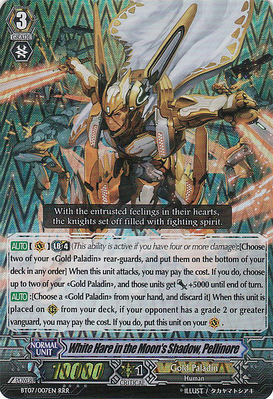 Galloping Golden Knight, Campbell is a Stride unit for Gold Paladins introduced as a Promo in G-Booster 2. On-hit, he can check the top 5 cards of your deck and call 1 unit from among them to an open Rear Guard circle. Combine this with something like Spring Breeze Messenger, the original Harbinger of Pellinore, and you have a whopping 8 chances of seeing the big bunny, meaning your chances of a double Vanguard attack just doubled. However, from an advantage standpoint, is it worth it?
Galloping Golden Knight, Campbell is a Stride unit for Gold Paladins introduced as a Promo in G-Booster 2. On-hit, he can check the top 5 cards of your deck and call 1 unit from among them to an open Rear Guard circle. Combine this with something like Spring Breeze Messenger, the original Harbinger of Pellinore, and you have a whopping 8 chances of seeing the big bunny, meaning your chances of a double Vanguard attack just doubled. However, from an advantage standpoint, is it worth it?
Say you begin the turn with 5 cards in hand and only have an unboosted Vanguard. You discard 1 to Stride into Campbell (-1), then attack and perform Triple Drive (+3). You hit and get to check the top 5 cards for a unit and call it to Rear Guard (+1), and since it gains 2,000 Power, it should be able to hit one of the opponent's units, forcing 1 card of guard (+1). This play has net you a total of +4 cards.
Now lets do the same turn, but with Pellinore. Stride into Campbell (-1) with Triple Drive (+3), and you hit. You now look at the top 5 cards and find Pellinore, who you call to Rear Guard (+1). You activate his skill to discard a card (-1), and ride him as Vanguard (-1). You now perform a new Twin Drive (+2). This yields a total of +3. However, this isn't taking into account the opponent's guarding Pellinore's attack. Since he's only a 10,000 Power unit, and more than likely their Vanguard will be 11,000, they can actually declare no guard and be safe, if you don't hit any triggers. Or they can use a 5,000 Shield for a 2-pass, or a 10,000 Shield for a no-pass. So at worse, using the Pellinore combo has put you at a -1 overall (3 cards vs. 4 cards in the first example), or a +0 on average. But from there you're sitting on a 10,000 Power Vanguard that essentially does nothing (His Limit Break is pretty crappy), with 1 less Grade 3 in the deck for Stride fodder. As a combo this is fairly lackluster, as you aren't actually gaining any advantage from it (unless you happen to get extremely lucky and manage to trigger sack your way to victory through it), and only stand to lose cards from it in the big picture. What's more, it requires dedicating quite a bit of deck space to the combo, which could otherwise go to better units that would be giving you mad plusses instead of possible break-evens.
